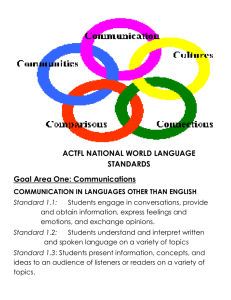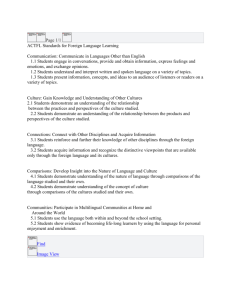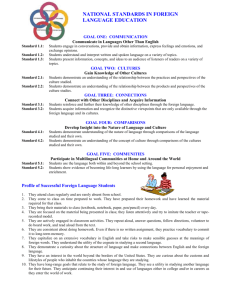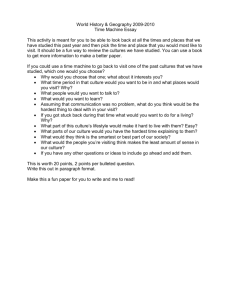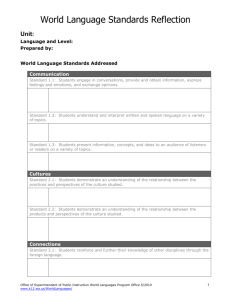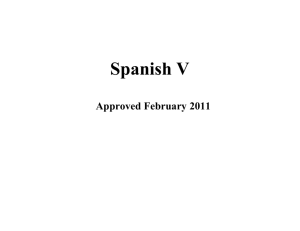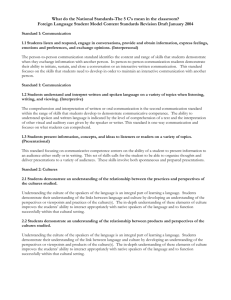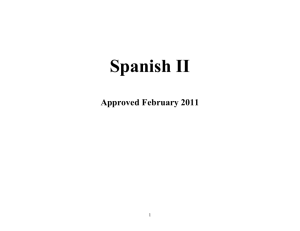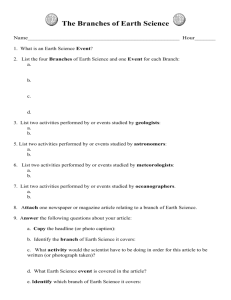Spanish I
advertisement
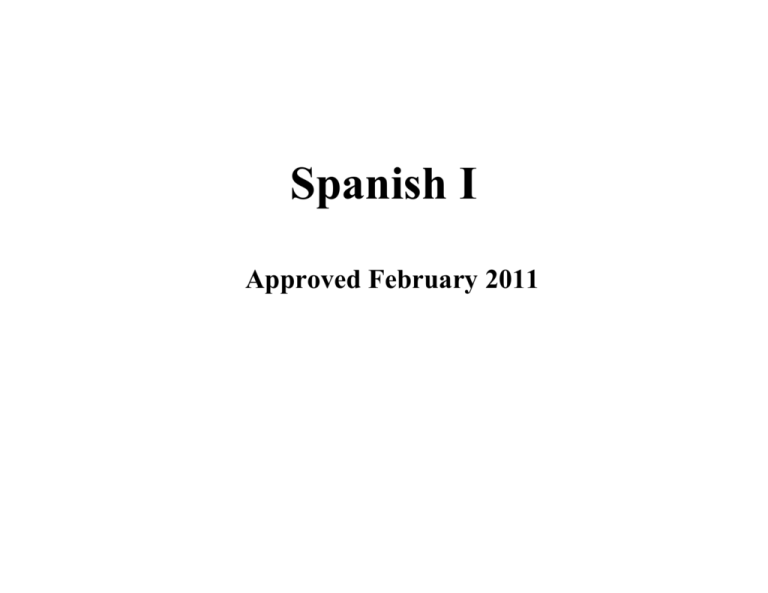
Spanish I Approved February 2011 Preliminary Unit: Para Empezar (“To Begin”) Essential Understandings: 1. Communicate in languages other than English 2. Gain knowledge and understanding of other cultures 3. Connect with other disciplines and acquire information 4. Develop insights into the nature of language and culture 5. Participate in multilingual communities at home and around the world Content Standards: 1.1: Students engage in conversations, provide and obtain information, express feelings and emotions, and exchange opinions. 1.2: Students understand and interpret written and spoken language in a variety of topics 1.3: Students present information, concepts, and ideas to an audience of listeners or readers on a variety of topics. 2.1: Students demonstrate an understanding of the relationship between the practices and perspectives of the culture studied. 2.2: Students demonstrate and understanding of the relationship between the products and perspectives of the culture studied. 3.1: Students reinforce and further their knowledge of other disciplines through the foreign language. 3.2: Students acquire information and recognize the distinctive viewpoints that are only available through the foreign language and its cultures. 4.1: Students demonstrate understanding of the nature of language through comparison of the language studied and their own. 4.2: Students demonstrate understanding of the concept of culture through comparisons and the cultures studied and their own. 5.1: Students use the language both within and beyond the school setting. 5.2: Students show evidence of becoming life-long learners by using the language for personal enjoyment and enrichment. Essential Question: What are some basic elements of learning to speak Spanish? Learning Goals: Students will be able to: Explain the importance of learning Spanish Introduce themselves to others and ask people’s names Respond appropriately to classroom directions Talk about classroom objects Ask questions about new words and phrases Identify Spanish-speaking countries Use the Spanish alphabet to spell words and names Greet people and say good-bye at different times of the day Tell how they are and ask how someone else is Use numbers 0 to 100 Tell time Identify parts of the body and ask and tell what hurts Describe weather conditions Identify the seasons 2 Talk and ask about days, dates and months Compare the seasons and weather in the northern and southern hemispheres Suggested Strategies Suggested Assessments Suggested Resources Suggested Tech Integration Content Vocabulary Lifelong Learning/21st Century Skills TPR (Total Physical Response) with adjectives Flashcards Music from a variety of sources Partner conversations Learning games: Bingo, Charades, Pictionary, Scrabble, Mime Vocabulary masters White boards Quizzes Tests, written and oral Informal Oral Daily Assessments White boards Realidades Level 1A (Middle School); Level 1 (High School) Realidades associated learning/activity materials Internet sites related to text and other Spanish/English Dictionary Clip art materials Spanish Language world map Realidades audio and video programs www.phschool.com teacher’s website and other learning sites Grammatical terminology in Spanish Geographical names in Spanish Classroom requests and terminology Quality work Communicate effectively Collaborate and cooperate Access and process information Core Ethical Values 3 Unit 2: “1A ¿Qué te gusta hacer?” (“What Do You Like to Do?”) Essential Understandings: 1. Communicate in languages other than English 2. Gain knowledge and understanding of other cultures 3. Connect with other disciplines and acquire information 4. Develop insights into the nature of language and culture 5. Participate in multilingual communities at home and around the world Content Standards: 1.1: Students engage in conversations, provide and obtain information, express feelings and emotions, and exchange opinions. 1.2: Students understand and interpret written and spoken language in a variety of topics 1.3: Students present information, concepts, and ideas to an audience of listeners or readers on a variety of topics. 2.1: Students demonstrate an understanding of the relationship between the practices and perspectives of the culture studied. 2.2: Students demonstrate and understanding of the relationship between the products and perspectives of the culture studied. 3.1: Students reinforce and further their knowledge of other disciplines through the foreign language. 3.2: Students acquire information and recognize the distinctive viewpoints that are only available through the foreign language and its cultures. 4.1: Students demonstrate understanding of the nature of language through comparison of the language studied and their own. 4.2: Students demonstrate understanding of the concept of culture through comparisons and the cultures studied and their own. 5.1: Students use the language both within and beyond the school setting. 5.2: Students show evidence of becoming life-long learners by using the language for personal enjoyment and enrichment. Essential Questions: How do we discuss activities we like and do not like to do? What are some important characteristics of Spanish art and music? Learning Goals: Students will be able to: Talk about activities they like and do not like to do Ask other what they like to do Discuss cultural perspectives on favorite activities Discuss outdoor cafes Listen to and discuss different types of music (meringue, salsa, flamenco, tango and cumbia) Identify musical instruments typical of Spanish-speaking countries Discuss pieces of art from Pablo Picasso and Jaime Colson Discuss historical influences on Spain 4 Suggested Strategies Suggested Assessments Suggested Resources Suggested Tech Integration Content Vocabulary Lifelong Learning/21st Century Skills TPR (Total Physical Response) with verb activities Flashcards Music from a variety of sources Partner conversations Learning games: Bingo, Charades, Pictionary, Scrabble, Mime Vocabulary masters White boards Computer laboratory and internet sites Quizzes Tests, written and oral Informal Oral Daily Assessments White boards Realidades Level 1A (Middle School); Level 1 (High School) Realidades associated learning/activity materials Spanish/English Dictionary Clip art materials Spanish language world map Realidades audio and video programs www.phschool.com teacher’s website and other learning sites Grammatical terminology in Spanish Geographical names in Spanish Classroom requests and terminology Productive habits of mind Quality work Read critically Communicate effectively Access and process information Core Ethical Values 5 Unit 3: “1B Y tú, ¿Cómo eres?” (“What are you like?”) Essential Understandings: 1. Communicate in languages other than English 2. Gain knowledge and understanding of other cultures 3. Connect with other disciplines and acquire information 4. Develop insights into the nature of language and culture 5. Participate in multilingual communities at home and around the world Content Standards: 1.1: Students engage in conversations, provide and obtain information, express feelings and emotions, and exchange opinions. 1.2: Students understand and interpret written and spoken language in a variety of topics 1.3: Students present information, concepts, and ideas to an audience of listeners or readers on a variety of topics. 2.1: Students demonstrate an understanding of the relationship between the practices and perspectives of the culture studied. 2.2: Students demonstrate and understanding of the relationship between the products and perspectives of the culture studied. 3.1: Students reinforce and further their knowledge of other disciplines through the foreign language. 3.2: Students acquire information and recognize the distinctive viewpoints that are only available through the foreign language and its cultures. 4.1: Students demonstrate understanding of the nature of language through comparison of the language studied and their own. 4.2: Students demonstrate understanding of the concept of culture through comparisons and the cultures studied and their own. 5.1: Students use the language both within and beyond the school setting. 5.2: Students show evidence of becoming life-long learners by using the language for personal enjoyment and enrichment. Essential Question: How do we ask and tell what people are like? Learning Goals: Students will be able to: Talk about personality traits Ask and tell what people are like Use the singular forms of the verb ser Use the singular definite and indefinite articles Use proper word order with adjectives Use correct adjective agreement Discuss cultural perspectives on friendship Talk about and write a type of poem known as the “Diamante” Discuss the “hiupil” worn by descendants of the Maya Discuss the life and art of Frida Kahlo Talk about the Spanish-speaking Caribbean Discuss the life of Simón Bolivar Compare African influence of the music of the Americas 6 Suggested Strategies Suggested Assessments Suggested Resources Suggested Tech Integration Content Vocabulary Lifelong Learning/21st Century Skills Computer laboratory and internet sites TPR (Total Physical Response) with adjectives Flashcards Music from a variety of sources Partner conversations Learning Games: Bingo, Charades, Pictionary, Scrabble, Mime Vocabulary masters White boards Quizzes Tests, written and oral Informal Oral Daily Assessments White Boards Realidades Level 1A (Middle School); Level 1 (High School) Realidades associated learning/activity materials Spanish/English Dictionary Clip art materials Spanish Language world map Realidades audio and video programs www.phschool.com teacher’s website and other learning sites Grammatical terminology in Spanish Geographical names in Spanish Classroom requests and terminology Productive habits of mind Quality work Read critically Communicate effectively Collaborate and cooperate Core Ethical Values 7 Unit 4: “2A Tu día en la escuela” (Your day at school) Essential Understandings: 1. Communicate in languages other than English 2. Gain knowledge and understanding of other cultures 3. Connect with other disciplines and acquire information 4. Develop insights into the nature of language and culture 5. Participate in multilingual communities at home and around the world Content Standards: 1.1: Students engage in conversations, provide and obtain information, express feelings and emotions, and exchange opinions. 1.2: Students understand and interpret written and spoken language in a variety of topics 1.3: Students present information, concepts, and ideas to an audience of listeners or readers on a variety of topics. 2.1: Students demonstrate an understanding of the relationship between the practices and perspectives of the culture studied. 2.2: Students demonstrate and understanding of the relationship between the products and perspectives of the culture studied. 3.1: Students reinforce and further their knowledge of other disciplines through the foreign language. 3.2: Students acquire information and recognize the distinctive viewpoints that are only available through the foreign language and its cultures. 4.1: Students demonstrate understanding of the nature of language through comparison of the language studied and their own. 4.2: Students demonstrate understanding of the concept of culture through comparisons and the cultures studied and their own. 5.1: Students use the language both within and beyond the school setting. 5.2: Students show evidence of becoming life-long learners by using the language for personal enjoyment and enrichment. Essential Question: How do we talk about school schedules and activities? Learning Goals: Students will be able to: Talk about school subjects and classes Talk about what they do during the day Ask and tell who is doing an action with AR verbs Use subject pronouns with the appropriate verb form Discuss activities during “recreo” Recognize various aspects of Mexican culture and history Recognize the influence of Latin on Spanish and English ordinal numbers and cognates Recognize the influence of the Roman civilization on Spain Compare their school with that of a student in a Spanish-speaking country 8 Suggested Strategies Suggested Assessments Suggested Resources Suggested Tech Integration Content Vocabulary Lifelong Learning/21st Century Skills Venn Diagrams TPR (Total Physical Response) with school subjects and verbs Flashcards Music from a variety of sources Partner conversations Learning Games: Bingo, Charades, Pictionary, Scrabble, Mime Vocabulary masters White boards Computer laboratory and internet sites Quizzes Tests, written and oral Informal Oral Daily Assessments White boards Realidades Level 1A (Middle School); Level 1 (High School) Spanish language world map Realidades associated learning/activity materials Spanish/English Dictionary Clip art materials Realidades audio and video programs www.phschool.com teacher’s website and other learning sites Grammatical terminology in Spanish Geographical names in Spanish Classroom requests and terminology Productive habits of mind Quality work Read critically Communicate effectively Collaborate and cooperate Access and process information Core Ethical Values 9 Unit 5: “2B Tu día en la escuela” (Your School Day) Essential Understandings: 1. Communicate in languages other than English 2. Gain knowledge and understanding of other cultures 3. Connect with other disciplines and acquire information 4. Develop insights into the nature of language and culture 5. Participate in multilingual communities at home and around the world Content Standards: 1.1: Students engage in conversations, provide and obtain information, express feelings and emotions, and exchange opinions. 1.2: Students understand and interpret written and spoken language in a variety of topics 1.3: Students present information, concepts, and ideas to an audience of listeners or readers on a variety of topics. 2.1: Students demonstrate an understanding of the relationship between the practices and perspectives of the culture studied. 2.2: Students demonstrate and understanding of the relationship between the products and perspectives of the culture studied. 3.1: Students reinforce and further their knowledge of other disciplines through the foreign language. 3.2: Students acquire information and recognize the distinctive viewpoints that are only available through the foreign language and its cultures. 4.1: Students demonstrate understanding of the nature of language through comparison of the language studied and their own. 4.2: Students demonstrate understanding of the concept of culture through comparisons and the cultures studied and their own. 5.1: Students use the language both within and beyond the school setting. 5.2: Students show evidence of becoming life-long learners by using the language for personal enjoyment and enrichment. Essential Questions: How do we describe where things are located in a classroom? How are our schools different from schools in Spanish-speaking countries? Learning Goals: Students will be able to: Describe a classroom Tell where objects are located using the verb estar and prepositions Describe differences between schools here and in Spanish-speaking countries Describe some facts about Central America 10 Suggested Strategies Suggested Assessments Suggested Resources Suggested Tech Integration Content Vocabulary Lifelong Learning/21st Century Skills Venn Diagrams TPR (Total Physical Response) with the verb estar plus prepositions and objects Flashcards Music from a variety of sources Partner conversations Learning Games: Bingo, Charades, Pictionary, Scrabble, Mime Vocabulary masters White boards Computer laboratory and internet sites Quizzes Tests, written and oral Informal Oral Daily Assessments White boards Realidades Level 1A (Middle School); Level 1 (High School) Spanish Language world map Realidades associated learning/activity materials Spanish/English Dictionary Clip art materials Realidades audio and video programs www.phschool.com teacher’s website and other learning sites Verb estar with prepositions showing location Classroom objects Productive habits of mind Quality work Read critically Communicate effectively Collaborate and cooperate Core Ethical Values 11 Unit 6: “3A ¿Desayuno o almuerzo?” (Breakfast or Lunch?) Essential Understandings: 1. Communicate in languages other than English 2. Gain knowledge and understanding of other cultures 3. Connect with other disciplines and acquire information 4. Develop insights into the nature of language and culture 5. Participate in multilingual communities at home and around the world Content Standards: 1.1: Students engage in conversations, provide and obtain information, express feelings and emotions, and exchange opinions. 1.2: Students understand and interpret written and spoken language in a variety of topics 1.3: Students present information, concepts, and ideas to an audience of listeners or readers on a variety of topics. 2.1: Students demonstrate an understanding of the relationship between the practices and perspectives of the culture studied. 2.2: Students demonstrate and understanding of the relationship between the products and perspectives of the culture studied. 3.1: Students reinforce and further their knowledge of other disciplines through the foreign language. 3.2: Students acquire information and recognize the distinctive viewpoints that are only available through the foreign language and its cultures. 4.1: Students demonstrate understanding of the nature of language through comparison of the language studied and their own. 4.2: Students demonstrate understanding of the concept of culture through comparisons and the cultures studied and their own. 5.1: Students use the language both within and beyond the school setting. 5.2: Students show evidence of becoming life-long learners by using the language for personal enjoyment and enrichment. Essential Question: How do we discuss food and dining? Learning Goals: Students will be able to: Talk about foods and beverages for breakfast and lunch Use correct forms of the verbs comer and beber to talk about what people eat and drink. Use adverbs Use the plural forms gustan and encantan to tell about foods they like and love Compare breakfast here with that in Spanish-speaking countries Name fruits and vegetables from the Americas 12 Suggested Strategies Suggested Assessments Suggested Resources Suggested Tech Integration Content Vocabulary Lifelong Learning/21st Century Skills Venn Diagrams TPR (Total Physical Response) to express food preferences Flashcards Music from a variety of sources Partner conversations Learning Games: Bingo, Charades, Pictionary, Scrabble, Mime Vocabulary masters White boards Computer laboratory and internet sites Quizzes Tests, written and oral Informal Oral Daily Assessments White boards Realidades Level 1A (Middle School); Level 1 (High School) Spanish Language world map Realidades associated learning/activity materials Spanish/English Dictionary Clip art materials Realidades audio and video programs www.phschool.com teacher’s website and other learning sites Verbs comer, beber, gustan, encantan Breakfast and lunch foods and beverages Productive habits of mind Quality work Read critically Communicate effectively Collaborate and cooperate Core Ethical Values 13 Unit 7: 3B: Para mantener la salud (Staying healthy) Essential Understandings: 1. Communicate in languages other than English 2. Gain knowledge and understanding of other cultures 3. Connect with other disciplines and acquire information 4. Develop insights into the nature of language and culture 5. Participate in multilingual communities at home and around the world Content Standards: 1.1: Students engage in conversations, provide and obtain information, express feelings and emotions, and exchange opinions. 1.2: Students understand and interpret written and spoken language in a variety of topics 1.3: Students present information, concepts, and ideas to an audience of listeners or readers on a variety of topics. 2.1: Students demonstrate an understanding of the relationship between the practices and perspectives of the culture studied. 2.2: Students demonstrate and understanding of the relationship between the products and perspectives of the culture studied. 3.1: Students reinforce and further their knowledge of other disciplines through the foreign language. 3.2: Students acquire information and recognize the distinctive viewpoints that are only available through the foreign language and its cultures. 4.1: Students demonstrate understanding of the nature of language through comparison of the language studied and their own. 4.2: Students demonstrate understanding of the concept of culture through comparisons and the cultures studied and their own. 5.1: Students use the language both within and beyond the school setting. 5.2: Students show evidence of becoming life-long learners by using the language for personal enjoyment and enrichment. Essential Questions: How do we stay healthy? What foods do we eat for dinner? Learning Goals: Students will be able to: Read, listen to and understand information about food groups and foods on the Food Guide Pyramid, activities to maintain good health and ways to describe food Talk about dinner foods Express food preferences Describe people and foods Talk about healthy and unhealthy lifestyles Use the plurals of adjectives with the verb “ser” Create a brochure about their favorite foods and ways they stay healthy 14 Suggested Strategies Suggested Assessments Suggested Resources Suggested Tech Integration Content Vocabulary Lifelong Learning/21st Century Skills Flashcards with clip art Mime and charades Partner interviews/conversations Listening comprehension activities Dice game for conjugations Vocubes Memory game BINGO Club de Cien Tests Quizzes Chapter Project Whiteboards Informal Daily Assessments Projects Realidades 1 Textbook Realidades 1 Practice Workbook Realidades 1 Teacher’s Resources English/Spanish dictionary Videohistoria GramActiva LCD projector Class website Food and beverages Hunger and thirst Health related vocabulary Indicating preferences Productive habits of mind Quality work Read critically Communicate effectively Collaborate and cooperate Access and process information Core Ethical Values 15 Unit 8: 4A: ¿Adónde vas? (Where do you go?) Essential Understandings: 1. Communicate in languages other than English 2. Gain knowledge and understanding of other cultures 3. Connect with other disciplines and acquire information 4. Develop insights into the nature of language and culture 5. Participate in multilingual communities at home and around the world Content Standards: 1.1: Students engage in conversations, provide and obtain information, express feelings and emotions, and exchange opinions. 1.2: Students understand and interpret written and spoken language in a variety of topics 1.3: Students present information, concepts, and ideas to an audience of listeners or readers on a variety of topics. 2.1: Students demonstrate an understanding of the relationship between the practices and perspectives of the culture studied. 2.2: Students demonstrate and understanding of the relationship between the products and perspectives of the culture studied. 3.1: Students reinforce and further their knowledge of other disciplines through the foreign language. 3.2: Students acquire information and recognize the distinctive viewpoints that are only available through the foreign language and its cultures. 4.1: Students demonstrate understanding of the nature of language through comparison of the language studied and their own. 4.2: Students demonstrate understanding of the concept of culture through comparisons and the cultures studied and their own. 5.1: Students use the language both within and beyond the school setting. 5.2: Students show evidence of becoming life-long learners by using the language for personal enjoyment and enrichment. Essential Question: How do we talk about where we go and what we do after school? Learning Goals: Students will be able to: Read, listen to and understand information about places to go when they are not in school Communicate about leisure activities Tell where they go and with whom Use the verb ir Ask questions Role-play a new student’s first day at school 16 Suggested Strategies Suggested Assessments Suggested Resources Suggested Tech Integration Content Vocabulary Lifelong Learning/21st Century Skills Flashcards with clip art Mime and charades Partner interviews/conversations Listening comprehension activities Dice game for conjugations Vocubes Memory game BINGO Club de Cien Tests Quizzes Chapter Project White boards Informal Daily Assessments Projects Realidades 1 Textbook Realidades 1 Practice Workbook Realidades 1 Teacher’s Resources English/Spanish dictionary Videohistoria GramActiva LCD projector Class website Leisure activities and places Question words Productive habits of mind Quality work Read critically Communicate effectively Core Ethical Values 17 Unit 9: 4B: ¿Quieres ir conmigo? (Do you want to go with me?) Essential Understandings: 1. Communicate in languages other than English 2. Gain knowledge and understanding of other cultures 3. Connect with other disciplines and acquire information 4. Develop insights into the nature of language and culture 5. Participate in multilingual communities at home and around the world Content Standards: 1.1: Students engage in conversations, provide and obtain information, express feelings and emotions, and exchange opinions. 1.2: Students understand and interpret written and spoken language in a variety of topics 1.3: Students present information, concepts, and ideas to an audience of listeners or readers on a variety of topics. 2.1: Students demonstrate an understanding of the relationship between the practices and perspectives of the culture studied. 2.2: Students demonstrate and understanding of the relationship between the products and perspectives of the culture studied. 3.1: Students reinforce and further their knowledge of other disciplines through the foreign language. 3.2: Students acquire information and recognize the distinctive viewpoints that are only available through the foreign language and its cultures. 4.1: Students demonstrate understanding of the nature of language through comparison of the language studied and their own. 4.2: Students demonstrate understanding of the concept of culture through comparisons and the cultures studied and their own. 5.1: Students use the language both within and beyond the school setting. 5.2: Students show evidence of becoming life-long learners by using the language for personal enjoyment and enrichment. Essential Question: How do we discuss activities outside of school? Learning Goals: Students will be able to: Read, listen to and understand information about activities outside of school in the U.S. and Latin America Talk about activities outside of school Extend, accept and decline invitations Tell when an event happens Say what they are going to do Use “ir + a + infinitive” and the verb jugar Create an invitation to an event outside of school 18 Suggested Strategies Suggested Assessments Suggested Resources Suggested Tech Integration Content Vocabulary Lifelong Learning/21st Century Skills Flashcards with clip art Mime and charades Partner interviews/conversations Listening comprehension activities Dice game for conjugations Vocubes Memory game BINGO Club de Cien Tests Quizzes Chapter project White boards Informal Daily Assessments Projects Realidades 1 Textbook Realidades 1 Practice Workbook Realidades 1 Teacher’s Resources English/Spanish dictionary Videohistoria GramActiva LCD projector Class website Sports vocabulary Leisure activities Time related vocabulary Invitation expressions Productive habits of mind Quality work Read critically Communicate effectively Collaborate and cooperate Access and process information Core Ethical Values 19
